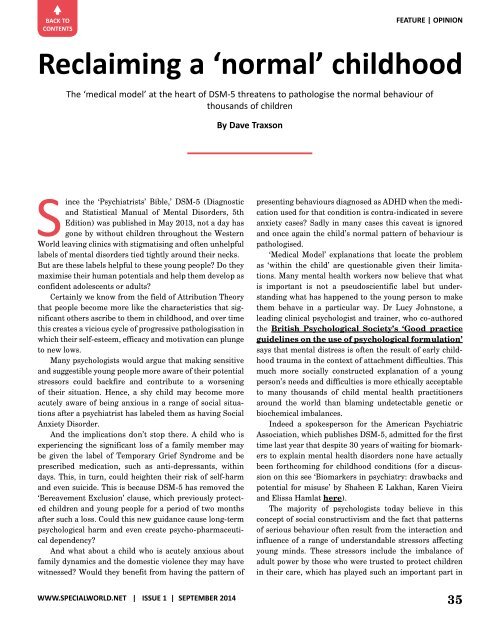special-world-issue-1
special-world-issue-1
special-world-issue-1
- No tags were found...
You also want an ePaper? Increase the reach of your titles
YUMPU automatically turns print PDFs into web optimized ePapers that Google loves.
BACK TOCONTENTSFEATURE | OPINIONReclaiming a ‘normal’ childhoodThe ‘medical model’ at the heart of DSM-5 threatens to pathologise the normal behaviour ofthousands of childrenBy Dave TraxsonSince the ‘Psychiatrists’ Bible,’ DSM-5 (Diagnosticand Statistical Manual of Mental Disorders, 5thEdition) was published in May 2013, not a day hasgone by without children throughout the WesternWorld leaving clinics with stigmatising and often unhelpfullabels of mental disorders tied tightly around their necks.But are these labels helpful to these young people? Do theymaximise their human potentials and help them develop asconfident adolescents or adults?Certainly we know from the field of Attribution Theorythat people become more like the characteristics that significantothers ascribe to them in childhood, and over timethis creates a vicious cycle of progressive pathologisation inwhich their self-esteem, efficacy and motivation can plungeto new lows.Many psychologists would argue that making sensitiveand suggestible young people more aware of their potentialstressors could backfire and contribute to a worseningof their situation. Hence, a shy child may become moreacutely aware of being anxious in a range of social situationsafter a psychiatrist has labeled them as having SocialAnxiety Disorder.And the implications don’t stop there. A child who isexperiencing the significant loss of a family member maybe given the label of Temporary Grief Syndrome and beprescribed medication, such as anti-depressants, withindays. This, in turn, could heighten their risk of self-harmand even suicide. This is because DSM-5 has removed the‘Bereavement Exclusion’ clause, which previously protectedchildren and young people for a period of two monthsafter such a loss. Could this new guidance cause long-termpsychological harm and even create psycho-pharmaceuticaldependency?And what about a child who is acutely anxious aboutfamily dynamics and the domestic violence they may havewitnessed? Would they benefit from having the pattern ofWWW.SPECIALWORLD.NET | ISSUE 1 | SEPTEMBER 2014presenting behaviours diagnosed as ADHD when the medicationused for that condition is contra-indicated in severeanxiety cases? Sadly in many cases this caveat is ignoredand once again the child’s normal pattern of behaviour ispathologised.‘Medical Model’ explanations that locate the problemas ‘within the child’ are questionable given their limitations.Many mental health workers now believe that whatis important is not a pseudoscientific label but understandingwhat has happened to the young person to makethem behave in a particular way. Dr Lucy Johnstone, aleading clinical psychologist and trainer, who co-authoredthe British Psychological Society’s ‘Good practiceguidelines on the use of psychological formulation’says that mental distress is often the result of early childhoodtrauma in the context of attachment difficulties. Thismuch more socially constructed explanation of a youngperson’s needs and difficulties is more ethically acceptableto many thousands of child mental health practitionersaround the <strong>world</strong> than blaming undetectable genetic orbiochemical imbalances.Indeed a spokesperson for the American PsychiatricAssociation, which publishes DSM-5, admitted for the firsttime last year that despite 30 years of waiting for biomarkersto explain mental health disorders none have actuallybeen forthcoming for childhood conditions (for a discussionon this see ‘Biomarkers in psychiatry: drawbacks andpotential for misuse’ by Shaheen E Lakhan, Karen Vieiraand Elissa Hamlat here).The majority of psychologists today believe in thisconcept of social constructivism and the fact that patternsof serious behaviour often result from the interaction andinfluence of a range of understandable stressors affectingyoung minds. These stressors include the imbalance ofadult power by those who were trusted to protect childrenin their care, which has played such an important part in35


